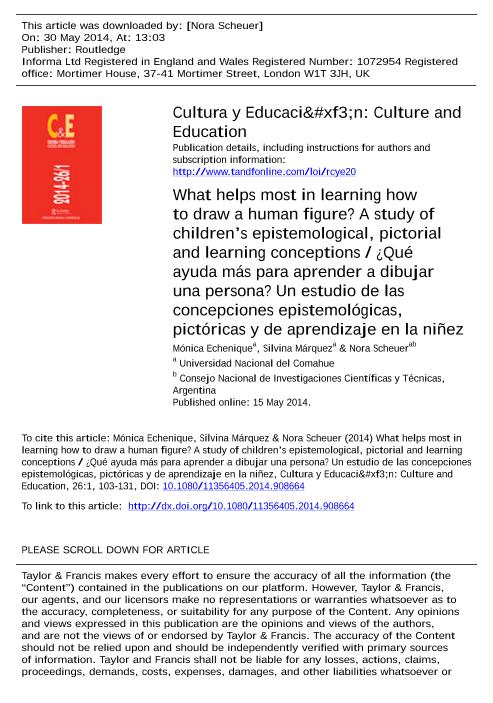Mostrar el registro sencillo del ítem
dc.contributor.author
Echenique, Mónica Haydée

dc.contributor.author
Márquez, María Silvina

dc.contributor.author
Scheuer, Nora

dc.date.available
2022-12-07T14:11:41Z
dc.date.issued
2014-05
dc.identifier.citation
Echenique, Mónica Haydée; Márquez, María Silvina; Scheuer, Nora; What helps most in learning how to draw a human figure?: A study of children`s epistemological, pictorial and learning conceptions; Taylor & Francis; Cultura y Educación; 26; 1; 5-2014; 103-131
dc.identifier.issn
1135-6405
dc.identifier.uri
http://hdl.handle.net/11336/180517
dc.description.abstract
Se explora cómo niños en edad escolar conciben fuentes relevantes del aprendizaje del dibujo de la figura humana: modelo vivo, fotografía, dibujo y pensamiento. Nos propusimos identificar sus preferencias al respecto, estudiar las valoraciones sobre las potencialidades que les atribuyen para aprender y analizar si esas justificaciones se relacionan con su nivel evolutivo-educativo según el grado escolar. Se entrevistó individualmente a 60 niños de primero (20), tercero (20) y quinto grado (20) de primaria. Las preferencias de los niños no variaron según el grado escolar, pero sí sus justificaciones del valor de cada fuente. Se muestra una evolución en la dirección de una mayor consideración de la flexibilidad de la agencia del dibujante/ aprendiz y de una incipiente posición epistemológica multiplista. Los resultados aportan a dos campos de investigación evolutiva-educativa: desarrollo de la representación gráfica y concepciones de aprendizaje y conocimiento.
dc.description.abstract
This study explores how school-aged children conceive relevant sources in learning how to draw the human figure: a live model, a photograph, a drawing and thought. Our purpose was to identify children's preferences in this regard, to study their evaluation of the potential for help they see in those sources, and analyse whether those justifications were related to children's developmental-educational level. Sixty children from first (20), third (20) and fifth year of elementary school (20) were interviewed individually. Children's preferences did not vary according to school level, but their justifications regarding the value of each source did. A developmental trend in the direction of a more flexible consideration of the drawer/learner's agency and of an incipient epistemological multiplism was found. Results contribute to two fields of developmental-educational research: development of graphical representation and conceptions of learning and knowledge.
dc.format
application/pdf
dc.language.iso
eng
dc.publisher
Taylor & Francis

dc.rights
info:eu-repo/semantics/openAccess
dc.rights.uri
https://creativecommons.org/licenses/by-nc-sa/2.5/ar/
dc.subject
CHILDREN
dc.subject
DEVELOPMENT
dc.subject
DRAWING
dc.subject
EPISTEMOLOGICAL BELIEFS
dc.subject
HUMAN FIGURE
dc.subject
LEARNING
dc.subject.classification
Otras Psicología

dc.subject.classification
Psicología

dc.subject.classification
CIENCIAS SOCIALES

dc.title
What helps most in learning how to draw a human figure?: A study of children`s epistemological, pictorial and learning conceptions
dc.title
¿Qué ayuda más para aprender a dibujar una persona?: Un estudio de las concepciones epistemológicas, pictóricas y de aprendizaje en la niñez
dc.type
info:eu-repo/semantics/article
dc.type
info:ar-repo/semantics/artículo
dc.type
info:eu-repo/semantics/publishedVersion
dc.date.updated
2022-12-06T17:14:51Z
dc.identifier.eissn
1578-4118
dc.journal.volume
26
dc.journal.number
1
dc.journal.pagination
103-131
dc.journal.pais
Reino Unido

dc.journal.ciudad
Oxford
dc.description.fil
Fil: Echenique, Mónica Haydée. Universidad Nacional del Comahue. Facultad de Ciencias de la Educación. Departamento de Psicología; Argentina
dc.description.fil
Fil: Márquez, María Silvina. Universidad Nacional del Comahue. Facultad de Ciencias de la Educación. Departamento de Psicología; Argentina
dc.description.fil
Fil: Scheuer, Nora. Consejo Nacional de Investigaciones Científicas y Técnicas. Centro Científico Tecnológico Conicet - Patagonia Norte; Argentina. Universidad Nacional del Comahue. Centro Regional Universitario Bariloche; Argentina
dc.journal.title
Cultura y Educación
dc.relation.alternativeid
info:eu-repo/semantics/altIdentifier/doi/http://dx.doi.org/10.1080/11356405.2014.908664
Archivos asociados
